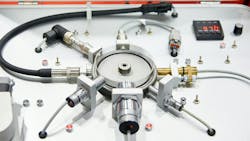Turning workforce challenges into digital opportunities
What you’ll learn:
- Plant management is running out of time—not just to replace those experts, but also to upskill the next generation of plant personnel.
- The very tools this new generation of reliability personnel need also provide a way to close the knowledge gap.
- Wireless sensors have made it possible to bring in more data from more assets.
The global personnel shortage in process manufacturing has been a creeping concern for many years. While many plants still have staff with decades of experience, many of those people are approaching—or even well past—retirement age.
Plant management is running out of time—not just to replace those experts, but also to upskill the next generation of plant personnel so they can keep their facilities running at peak safety and efficiency.
See also: With MFT use growing among manufacturers, new findings see critical cybersecurity gaps
Further complicating this scenario is the fact that the next generation of reliability personnel work in a very different way than their predecessors. Today’s newest technicians grew up in a highly connected world and have higher expectations from technology—and its ability to assist them in their tasks—than any previous generation.
These users are not only able to use modern digital solutions to help them perform at their best; they also expect those solutions to be available and up to date. Attracting the best talent will therefore mean providing them with the digital tools they need to deliver on their capabilities.
These same workers are also far more transitory than their predecessors. It’s no longer safe to assume that a new hire will stay in a role for decades and become the resident expert in a very targeted role.
See also: AI sparks demand for specialized, high-performance plant infrastructure
Today’s plant personnel are regularly moving between roles every three to five years, taking their expertise with them, making it hard to maintain a deep store of knowledge onsite.
Fortunately, the very tools this new generation of reliability personnel need also provide a way to close the knowledge gap. With the right continuous condition monitoring solutions and machinery health software in place, process manufacturers can attract the best reliability talent, bring them up to speed quickly, and build an infrastructure for knowledge capture and transfer. This approach makes it far easier to support safety and reliability in the plant for decades to come.
Increasing visibility
The foundation of a good reliability program is quality data. Teams—especially those made up of digital natives leveraging technology to drive results—need regular access to contextualized data to make good, timely decisions. In today’s high-efficiency, small-team environment, collecting that data successfully often means rethinking traditional strategies.
Q&A: Roadmap to Industry 5.0 with Ganesh Bukka of Hitachi Digital Services
Scheduled data collection rounds have been a staple of plant reliability for decades and will likely always be a critical part of ensuring the reliable operation of assets.
However, today’s plants not only need to maintain continuous operation, but must do so while also managing efficiency, improving sustainability, reducing energy consumption, and more. Accomplishing all these goals simultaneously is nearly impossible with a stream of raw data only coming in every 30 to 60 days.
Fortunately, modern sensing technologies are more ubiquitous and affordable than ever before. Wireless sensors have made it possible to bring in more data from more assets, at a pace that supports the predictive maintenance software that puts contextualized data directly into the hands of digital-native personnel.
One of the key benefits of modern wireless sensors is increased cadence of data delivery. Instead of waiting 30 to 60 days for asset health data, reliability teams can gather data daily, or even more frequently, without the need for manual rounds.
See also: The hardware problem that is stalling half of all digital transformation projects
This fast delivery of data dramatically reduces the risk that reliability teams will miss faults in their equipment because a problem developed and escalated quickly just after the last data collection. It also provides the higher quantities and more frequent delivery of data necessary to track and trend machinery health via analytics.
Dealing with data
As reliability teams instrument their equipment to bring in data continuously, they will need reliable ways to turn that raw data into actionable information.
Traditionally, that transformation has been completed by expert analysts who pore over raw data and deliver insights based on the trends they see in spectrum and waveform data. Today, however, small teams struggle to find the time for analysts to dig into all the plant’s data. Moreover, many teams have no expert analysts at all.
Modern machinery health software helps solve the problem of turning raw data into actionable information by leveraging machine-learning-based analytics to help teams quickly identify the most common problems with rotating machinery.
See also: IT-OT convergence as a driver for manufacturing innovation
The most advanced machinery health solutions are built on decades of industrial reliability expertise and automatically trend raw data—including subtle high-frequency signatures—to deliver earlier, more accurate indications of developing faults. Then, using logical, rule-based models, the software alerts users to problems with indication of where the fault originated.
For teams that already have a deep bench of analysts, machinery health software reduces the overhead of analyzing vast data sets and identifying common faults, freeing experts to focus on more complex problems.
For lean teams with few or no analysts, the automated reporting built into machinery health software delivers easy-to-understand machinery health updates and at-a-glance status of overall plant health, with simple indicators to help teams prioritize maintenance actions.
Seamless solutions
One of the key challenges of modern reliability strategy is selecting the best solutions from the many options available in the market. Teams looking to get the most value across the lifecycle of their investment should seek solutions built on true mechanical and fault diagnostic principles.
The most experienced automation solutions providers build their solutions on extensive knowledge of failure modes and their impacts on machinery and then build powerful machine learning models to digest data into meaningful information for the user.
See also: ‘Digital retrofitting’ of plant machines offers course through Industry 4.0 to Industry 5.0
Today, some of the most powerful analytics tools are even built into the sensors themselves. These sensors perform analysis at the edge, directly notifying users of developing faults on essential equipment, while simultaneously updating and trending the equipment status in the plant’s machinery health software.
To make it easier to implement and maintain these solutions across the lifecycle, many reliability teams are following a boundless automation vision for the implementation of new sensors and software.
By focusing on technologies that are seamlessly integrated from the field, through the edge, and into the cloud, they can more quickly deploy and gain value from their new solutions.
The moment for modernization
Efficient condition monitoring practices and effective machinery health software are critical tools to help today’s reliability teams navigate the complexity of personnel shifts.
Such solutions not only provide fast, actionable information to help less experienced users thrive, they also help preserve critical institutional knowledge and foster increased collaboration, making it easier for plants to run efficiently, even with lean teams.
The best solutions on the market are comprehensive across asset types and designed to be easy to install, configure, and maintain. There has never been a better time to modernize using these types of solutions.
About the Author

David Kapolnek
David Kapolnek is director of product management for Emerson’s Reliability Solutions business. In this role since 2020, Kapolnek has led development and deployment of information-based software tools and services that help manufacturers improve effectiveness and efficiency of their work practices. He has held product leadership roles in numerous organizations, with a focus on facilitation of high value user workflows through hardware and software-based systems.
